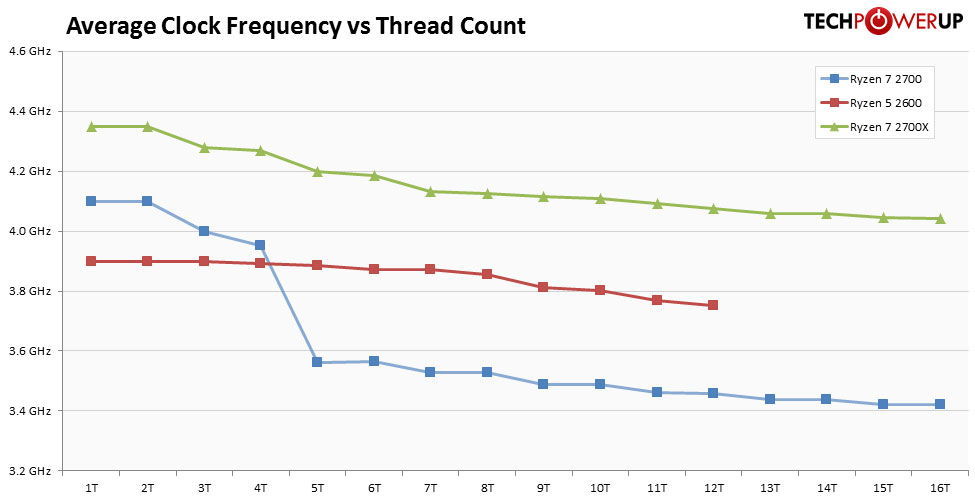 10
10
AMD Ryzen 5 2600 3.4 GHz Review
Power Consumption & Efficiency »Clock Frequencies and Boost Clock Analysis
Most modern processors feature a capability called "Boost" or "Turbo" that automatically overclocks the CPU beyond the nominal clock frequency provided certain conditions related to thread count, power draw, and temperatures are met. Our testing on this page investigates what actual real-life frequencies can be achieved in such scenarios. The data below presents the minimum, maximum, and average clock frequency of a given core/thread-count combination for a typical heavy workload. We start with one thread and go all the way up to the CPU's maximum thread count while at the same time measuring the average clock frequency for these timed testing runs.
The Ryzen 5 2600 can hold its maximum boost clock with up to five threads. The chip's clock speed is unshakable from 3.90 GHz with 1-3 threads. As we approach 4-thread, there's a negligible decay of 8 MHz because this is probably the point at which the processor is deciding on whether to sustain maximum boost clocks or to switch to a lower boost state, because it's not just dealing with our 4-thread load, but some load blips on other cores from background OS tasks that are guiding the decision. This becomes more pronounced as we reach 5-thread, at which point the observed frequency is 3.88 GHz.
As we step up the gas to 6-thread and 7-thread, clock speeds drop by 25 MHz ("Zen" chips have a multiplier granularity of 0.25x), to around 3.875 GHz. The 8-thread load sheds another 25 MHz to around 3.85 GHz. With 9-thread and 10-threads, it sheds yet another 25 MHz to 3.80 GHz, and a drop of another 50 MHz takes place as we reach 11-thread and 12-thread.
When we tested the Ryzen 7 2700 recently, we noticed that its boost clock fell off a cliff beyond 4-thread, by almost 450 MHz, and as we reached its maximum 16-thread state, it lost a stunning 1 GHz of boost clock, staying just 200 MHz above the nominal clock. So we did a comparative analysis:

As you can see, the Ryzen 7 2700 boost clock steadily deteriorates as we increase its multi-threaded load, with a steep fall beyond 4-thread. The Ryzen 5 2600, on the other hand, very gradually loses clock speeds, and in very small amounts (often by 25 MHz, rarely 50 MHz), with almost no steep drops and near-maximum boost sustained until 6-thread, and only a drop by 150 MHz at it maximum 12-threaded workload (compare that to the 1 GHz the Ryzen 7 2700 loses at max workload!).
The only possible explanation is TDP. AMD is positioning the Ryzen 7 2700 and Ryzen 5 2600 as "high efficiency" SKUs and set their TDP at 65 W. The 2700 has two more cores and four more threads than the 2600, and hence, there is an effort to keep its TDP at 65 W, which punishes its boost clock harder. Its clock speed hence drops by a stunning 450 MHz beyond 4-thread, and by 1 GHz at 16-thread. The Ryzen 5 2600 has fewer cores and is hence more comfortable in sustaining its boost clocks.
When not loaded at all, the processor's idle clock is 1550 MHz.
Apr 23rd, 2024 19:24 EDT
change timezone
Latest GPU Drivers
New Forum Posts
- What's your latest tech purchase? (20311)
- need help with motherboard/ ram compability certainty (13)
- Sexy Mechanical Keyboard Thread (482)
- My computer setup - Request for opinions (12)
- Show us your collections thread!! (282)
- Realtek Modded Audio Driver for Windows 10/11 - Only for HDAUDIO (5687)
- What phone you use as your daily driver? And, a discussion of them. (1454)
- Is there a technical reason that Windows 11 doesn't have built into it battery charge limitation? (37)
- ThrottleStop 9.6 Voltage won't change (1)
- FINAL FANTASY XIV: Dawntrail Official Benchmark (71)
Popular Reviews
- Horizon Forbidden West Performance Benchmark Review - 30 GPUs Tested
- Fractal Design Terra Review
- Corsair 2000D Airflow Review
- Thermalright Phantom Spirit 120 EVO Review
- Minisforum EliteMini UM780 XTX (AMD Ryzen 7 7840HS) Review
- ASUS GeForce RTX 4090 STRIX OC Review
- NVIDIA GeForce RTX 4090 Founders Edition Review - Impressive Performance
- ASUS GeForce RTX 4090 Matrix Platinum Review - The RTX 4090 Ti
- Creative Pebble X Plus Review
- MSI GeForce RTX 4090 Gaming X Trio Review
Controversial News Posts
- Sony PlayStation 5 Pro Specifications Confirmed, Console Arrives Before Holidays (116)
- NVIDIA Points Intel Raptor Lake CPU Users to Get Help from Intel Amid System Instability Issues (106)
- AMD "Strix Halo" Zen 5 Mobile Processor Pictured: Chiplet-based, Uses 256-bit LPDDR5X (101)
- US Government Wants Nuclear Plants to Offload AI Data Center Expansion (98)
- Windows 10 Security Updates to Cost $61 After 2025, $427 by 2028 (84)
- Developers of Outpost Infinity Siege Recommend Underclocking i9-13900K and i9-14900K for Stability on Machines with RTX 4090 (84)
- TechPowerUp Hiring: Reviewers Wanted for Motherboards, Laptops, Gaming Handhelds and Prebuilt Desktops (74)
- Intel Realizes the Only Way to Save x86 is to Democratize it, Reopens x86 IP Licensing (70)